NCERT Exemplar Class 11 Chemistry Chapter 9 Hydrogen are part of NCERT Exemplar Class 11 Chemistry . Here we have given NCERT Exemplar Class 11 Chemistry Chapter 9 Hydrogen.
NCERT Exemplar Class 11 Chemistry Chapter 9 Hydrogen
Multiple Choice Questions
Single Correct Answer Type
Q1. Hydrogen resembles halogens in many respects for which several factors are responsible. Of the following factors which one is most important in this respect?
(a) Its tendency to lose an electron to form a cation.
(b) Its tendency to gain a single electron in its valence shell to attain stable electronic configuration.
(c) Its low negative electron gain enthalpy value.
(d) Its small size.
Sol:
(b) Halogens have the tendency to gain one electron and acquire inert gas configuration. Hydrogen also accepts one electron and acquires helium configuration.

Q2. Why does H
+
ion always get associated with other atoms or molecules?
(a) Ionisation enthalpy of hydrogen resembles that of alkali metals.
(b) Its reactivity is similar to halogens.
(c) It resembles both alkali metals and halogens.
(d) Loss of an electron from hydrogen atom results in a nucleus of very small size as compared to other atoms or ions. Due to small size it can not exist freely.
Sol:
(d) H→H
+
+e
–
H
+
has a very small size (~1.5 x 10
-3
pm) compared to normal atomic and ionic sizes of 50 to 220 pm. It does not exist freely and is always associated with other atoms or molecules.
Q3. Metal hydrides are ionic, covalent or molecular in nature. Among LiH, NaH, KH, RbH, CsH, the correct order of increasing ionic character is
(a) LiH > NaH > CsH > KH > RbH
(b) LiH < NaH < KH < RbH < CsH
(c) RbH > CsH > NaH > KH > LiH
(d) NaH > CsH > RbH > LiH > KH
Sol:
(b) Ionic character increases as the size of the atom increases.
LiH < NaH < KH < RbH < CsH
Q4. Which of the following hydrides is electron-precise hydride?
(a) B
2
H
6
(b) NH
3
(c) H
2
0
(d) CH
4
Sol:
(d) CH
4
is an electron precise hydride since there are exact number of electrons to form normal covalent bonds.
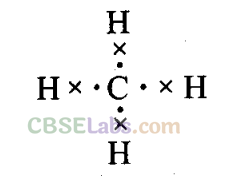
Q5. Radioactive elements emit a, p and y rays and are characterized by their half lives. The radioactive isotope of hydrogen is
(a) Protium (b) Deuterium (c) Tritium (d) Hydronium
Sol:
(c) Nucleides with n/p (neutron-proton) ratio > 1.5 are usually radioactive. For example, tritium (n = 2,p = 1).
Q6. Consider the reactions
(A) H
2
0
2
+ 2HI → I
2
+ 2H
2
0
(B) HOCl + H
2
O
2
→ H
3
0
+
+ Cl
‑
+ 0
2
Which of the following statements is correct about H
2
0
2
with reference to these reactions? Hydrogen peroxide is _______
(a) an oxidizing agent in both (A) and (B)
(b) an oxidizing agent in (A) and reducing agent in (B)
(c) a reducing agent in (A) and oxidizing agent in (B)
(d) a reducing agent in both (A) and (B)

O.N. of oxygen is decreased from -1 (H
2
0
2
) to -2 (H
2
0), therefore, it is reduced and acts as an oxidizing agent.

O.N. of oxygen is increased from -1 (H 2 0 2 ) to 0 (0 2 ), therefore, it is oxidized and acts as a reducing agent.
Q7. The oxide that gives H
2
0
2
on treatment with dilute H
2
S0
4
is
(a) Pb0
2
(b) Ba0
2
-8H
2
0
(c) Mn0
2
(d) Ti0
2

Q8. Which of the following equatibns depicts the oxidizing nature of H
2
0
2
?
(a) 2Mn0
–
4
+ 6H
+
+ 5H
2
0
2
→ 2Mn
2+
+ 8H
2
0 + 50
2
(b) 2Fe
3+
+ 2H
+
+ H
2
0
2
→ 2Fe
2+
+ 2H
2
0 + 0
2
(c) 2I
–
+ 2H
+
+ H
2
0
2
→ I
2
+ 2H
2
0
(d) KI0
4
+ H
2
0
2
→ KI0
3
+ H
2
0 + 0
2

Q9. Which of the following equations depicts reducing nature of H
2
0
2
?
(a) 2[Fe(CN)
6
]
4-
+ 2H
+
+ H
2
0
2
→ 2[Fe(CN)
6
]
3-
+ 2H
2
0
(b) I
2
+ H
2
0
2
+ 2OH
–
→ 2I
–
+ 2H
2
0 + 0
2
(c) Mn
2+
+ H
2
0
2
→ Mn
4+
+ 20H
(d) PbS + 4H
2
0
2
→ PbS0
4
+ 4H
2
0
Sol:
(b) I
2
+ H
2
0
2
+ 2OH
–
→ 2I
–
+ 2H
2
0 + 0
2
I
2
is reduced to I
–
. Thus, H
2
0
2
acts as a reducing agent.
Q10. Hydrogen peroxide is ._________ .
(a) an oxidizing agent
(b) a reducing agent
(c) both an oxidizing and a reducing agent
(d) neither oxidizing nor reducing agent.
Sol:
(c) H
2
0
2
acts both as oxidizing and reducing agent.
Q11. Which of the following reactions increases production of dihydrogen from synthesis gas?

Sol: (c) To increase the production of H2 from synthesis gas, CO is oxidized to C0 2 by passing it over steam at 673 K in presence of a catalyst.

Q12. When sodium peroxide is treated with dilute sulphuric acid, we get .
(a) sodium sulphate and water
(b) sodium sulphate and oxygen
(c) sodium sulphate, hydrogen and oxygen
(d) sodium sulphate and hydrogen peroxide.

Q13. Hydrogen peroxide is obtained by‘the electrolysis of _______.
(a) water
(b) sulphuric acid
(c) hydrochloric acid
(d) fused sodium peroxide
Sol:
(b) Hydrogen peroxide is obtained by electrolysis of sulphuric acid.
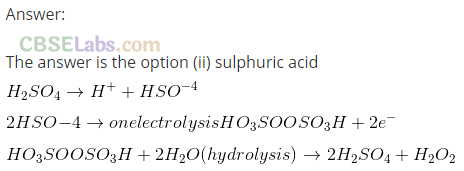
Q14. Which of the following reactions is an example of use of water gas in the synthesis of other compounds?

Sol: (d) Water gas is used in synthesis of compounds like methanol.
Q15. Which of the following ions will cause hardness in water sample?

Q16. Which of the following compounds is used for water softening?
(a) Ca
3
(P0
4
)
2
(b) Na
3
P0
4
(c) Na
6
P
6
0
18
(d) Na
2
HP0
4
Sol:
(c)Na
6
P
6
0
18
(Sodium hexametaphosphate) commercially known as calgon is used for water softening.
2CaCl
2
+ Na
2
[Na
4
(P0
3
)
6
] →Na
2
[Ca
2
(P0
3
)
6
] + 4NaCl
Q17. Elements of which of the following group(s) of periodic table do not form hydrides?
(a) Groups 7,8, 9
(b) Group 13
(c) Group 15,16, 17
(d) Group 14
Sol:
(a) Group 7, 8, 9 elements do not form hydrides.
Q18. Only one element of forms hydride.
(a) group 6
(b) group 7
(c) group 8
(d) group 9
Sol:
(a) Only one element chromium from group 6 forms hydride, (CrH).
More than One Correct Answer Type
Q19. Which of the following statements are not true for hydrogen?
(a) It exists as diatomic molecule.
(b) It has one electron in the outermost shell.
(c) It can lose an electron to form a cation which can freely exist.
(d) It forms a large number of ionic compounds by losing an electron.
Sol.
(c, d) It can lose an electron to form a cation which cannot freely exist.
Generally, it does not form ionic compounds by losing an electron but forms a large number of covalent compounds by sharing electron.
Q20. Dihydrogen can be prepared on commercial scale by different methods. In its preparation by the action of steam on hydrocarbons, a mixture of CO and H2 gas is formed. It is known as ____
_ .
(a)water gas
(b)
syn gas
(c) producer gas
(d) industrial gas
Sol:
(a, b) A mixture of CO + H
2
is known as water gas or syn gas (synthesis gas).
Q21. Which of the following statement(s) is/are correct in the case of heavy water?
(a) Heavy water is used as a moderator in nuclear reactor.
(b) Heavy water is more effective as solvent than ordinary water.
(c) Heavy water is more associated than ordinary water.
(d) Heavy water has lower boiling point than ordinary water.
Sol:
(a, c) Heavy water is used as a moderator in nuclear reactor and is more associated than ordinary water.
Q22.Which of the following statements about hydrogen are correct?
(a) Hydrogen has three isotopes of which protium is the most common.
(b) Hydrogen never acts as cation in ionic salts.
(c) Hydrogen ion, H
+
, exists freely in solution.
(d) Dihydrogen does not act as a reducing agent.

Q23. Some of the properties of water are described below. Which of them is/are not correct?
(a) Water is known to be universal solvent.
(b) Hydrogen bonding is present to a large extent in liquid water.
(c) There is no hydrogen bonding in the frozen state of water.
(d) Frozen water is heavier than liquid water.
Sol:
(c, d) There is extensive hydrogen bonding in ice. Ice is lighter than water due to empty spaces present in tetrahedrons formed by hydrogen bonds.
Q24. Hardness of water may be temporary or permanent. Permanent hardness is due to the presence of
(a) Chlorides of Ca and Mg in water
(b) Sulphate of Ca and Mg in water
(c) Hydrogen carbonates of Ca and Mg in water
(d) Carbonates of alkali metals in water.
Sol:
(a, b) Permanent hardness of water is due to presence of following salts: CaCl
2
; MgCl
2
; CaS0
4
; MgS0
4
Q25. Which of the following statements are correct?
(a) Elements of group 15 form electron deficient hydrides.
(b) All elements of group 14
form
electron precise hydrides.
(c) Electron precise hydrides have tetrahedral geometries.
(d) Electron rich hydrides can act as Lewis acids.
Sol:
(b, c) All elements of group 14 form electron precise hydrides like CH4 which are tetrahedral in geometry.
Q26. Which of the following statements are correct?
(a) Hydrides of group 13 act as Lewis acids.
(b) Hydrides of group 14 are electron deficient hydrides.
(c) Hydrides of group 14 act as Lewis acids.
(d) Hydrides of group 15 act as Lewis bases.
Sol:
(a, d) All elements of group 13 will form electron deficient compounds which acts as Lewis acids.
All elements of group 14 will form electron precise compounds.
Electron rich hydrides have excess electrons which are present as lone pairs. Elements of group 15-17 form such compounds. NH3 has one lone pair, H20 has two lone pairs and HF has three lone pairs, and so these compounds act as Lewis bases.
Q27. Which of the following statements are correct?
(a) Metallic hydrides are deficient of hydrogen.
(b) Metallic hydrides conduct heat and electricity.
(c) Ionic hydrides do not conduct electricity in solid state.
(d) Ionic hydrides are very good conductors of electricity in solid state.
Sol:
(a, b, c) Metallic hydrides are non-stoichiometric hydrides. They conduct heat and electricity. Ionic hydrides conduct electricity only in molten or aqueous state.
Short Answer Type Questions
Q28. How can production of hydrogen from water gas be increased by using water gas shift reaction?
Sol:
Water gas is produced when superheated steam is passed over red hot coke or coal at 1270 K in the presence of nickel as catalyst.

Pure H
2
from water gas cannot be obtained easily because it is difficult to remove CO. Therefore, to increase the production of H
2
from water gas, CO is oxidized to C0
2
by mixing it with more steam and passing the mixture over heated FeCr0
4
catalyst at 673 K.
The C0 2 produced is removed by scrubbing with sodium arsenite solution.
Q29. What are metallic/interstitial hydrides? How do they differ from molecular hydrides?
Sol:
Metallic hydrides are formed by d- and f-
:
block elements. Their hydrides conduct heat and electricity. They are non-stoichiometric, being deficient in hydrogen. For example, LaH
2.87
, ybH
2.55
etc.
| Metallic hydrides | Molecular hydrides | ||
| (1) | These are formed by eland f-block elements. | (1) | These are formed by p-block elements and some s-block elements (Be and Mg). |
| (2) | They conduct electricity. | (2) | They do not conduct electricity. |
| (3) | They are hard and have metallic luster. | (3) | They are volatile compounds having low melting and boiling points. |
Q30. Name the classes of hydrides to which H
2
0, B
2
H
6
and NaH belong.
Sol:
H
2
0 – Electron rich covalent hydride/molecular hydride
B
2
H
6
– Electron deficient molecular hydride
NaH – Ionic hydride
Q31. If same mass of liquid water and a piece of ice are taken, then why is the density of ice less than that of liquid water?
Sol:
The mass per unit volume (i.e., mass/volume) is called density. Since water expands on freezing, therefore, volume of ice for the same mass of water is more than liquid water. In other words, density of ice is lower than liquid water and hence ice floats on water.
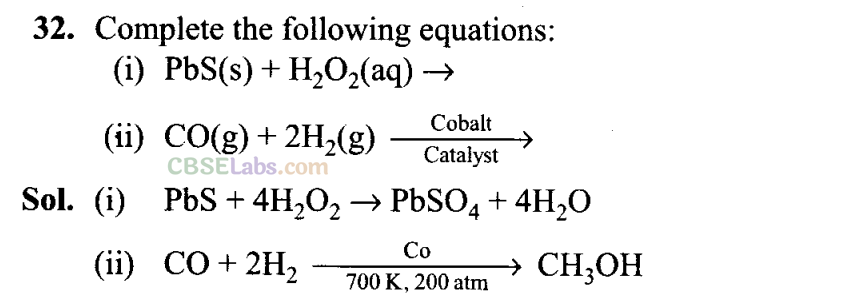
Q33. Give reasons:
(i) Lakes freeze from top towards bottom.
(ii) Ice floats on water.
Sol:
(i) During severe winter, the temperature of water in the lake keeps on decreasing. Since cold water is heavier, it keeps on going into the interior of the lake while warm water keeps on coming to the surface of the lake. This process continues till the temperature of entire water of lakes becomes 4°C. Since density of water is maximum at 277 K, any further decrease in the temperature will decrease its density. As a result, the temperature of the surface water keeps on decreasing and it ultimately freezes. Now, any further decrease in the temperature will decrease the temperature of water below 4°C. This process continues and as a result, the lakes keep on freezing from top to bottom.
(ii) Density of ice is less than water due to presence of empty spaces created because of H-bonding between H
2
0 molecules. Hence, ice floats on water.
Q34. What do you understand by the term ‘auto-protolysis of water? What is its significance?
Sol:
Autoprotolysis is a reaction in which two same molecules react to give ions with proton transfer. Water undergoes autoproteolysis, i.e., a proton from one molecule is transferred to another molecule.

On account of autoprotolysis, water is amphoteric in nature.
Q35. Discuss briefly de-mineralisation of water by ion exchange resin.
Sol:
Demineralised water free from all soluble mineral salts is obtained by passing water successively through a cation exchange and an anion exchange resin.
In cation exchange process, H
+
exchanges for Na
+
, Ca
2+
, Mg
2+
and in the anion exchange process OH exchanges for anions like CH, HCO3, S0
2-
4
, etc. H
+
and OH
–
released combine to form water.
H
+
+ OH
–
→ H
2
0
Q36
. Molecular hydrides are classified as electron deficient, electron precise and electron rich compounds. Explain each type with two examples.
Sol:
Covalent or molecular hydrides are classified into three categories:
(i) Electron deficient hydrides:
These hydrides do not have sufficient number of electrons to form normal covalent bonds. Examples are the hydrides of group 13 such as B
2
H
6
, (AlH
3
)
n
etc.
(ii) Electron precise hydrides:
These have exact number of electrons to form normal covalent bonds. Examples are the hydrides of group 14 such as CH
4
, SiH
4
, etc.
(iii) Electron rich hydrides:
These have more number of electrons than normal covalent bonds. The excess electrons are present in the form of lone pairs. Examples are the hydrides of group 15, 16 and 17 such as

Q37. How is heavy water prepared? Compare its physical properties with those of ordinary water.
Sol:
Heavy water can be prepared by exhaustive electrolysis of water. Comparison of physical properties of H
2
0 and D
2
0.
| Property | H2 o | D2 o | |
| (i) | Molecular mass (g mol -1 ) | 18.015 | 20.027 |
| (ii) | Melting point (K) | 273.0 | 276.8 |
| (iii) | Boiling point (K) | 373.0 | 374.4 |
| (iv) | Density (298 K) g cm- 3 | 1.0000 | 1.1059 |
| (v) | Enthalpy of vapourisation (kJ mol -1 ) | 40.66 | 41.61 |
Q38. Write one chemical reaction for the preparation of D
2
0
2
.
Sol:
D
2
0
2
can be prepared by the reaction of D
2
S0
4
dissolved in water over Ba0
2
.
Ba0
2
+ D
2
S0
4
→ BaS0
4
+ D
2
0
2
Q39. Calculate the strength of 5 volume H
2
0
2
Sol:
5 volume H
2
0
2
solution means that 1 L of 5 volume H
2
0
2
on decomposition gives 5L of 0
2
at NTP.
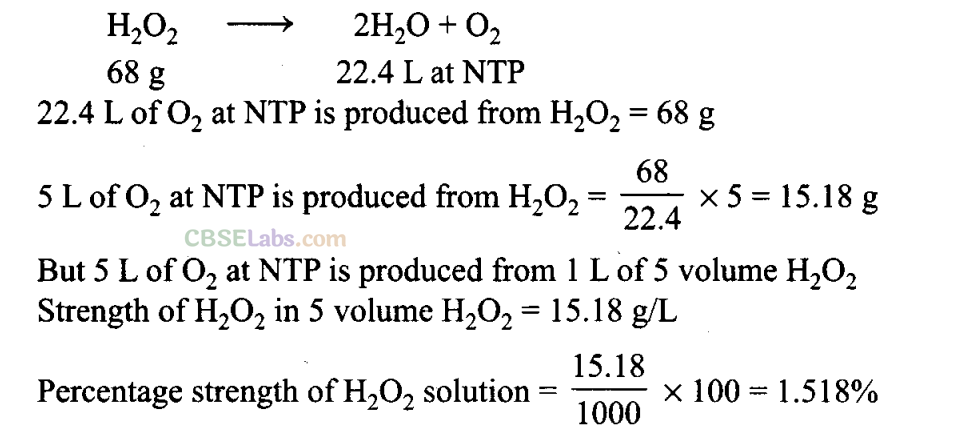
Q40. (i)Draw the gas phase and solid phase structure of H
2
0
2
.
(ii) H
2
0
2
is a better oxidizing agent than water. Explain.
Sol:
(i) Structure of H
2
0
2
is slightly different in gas phase and solid phase.
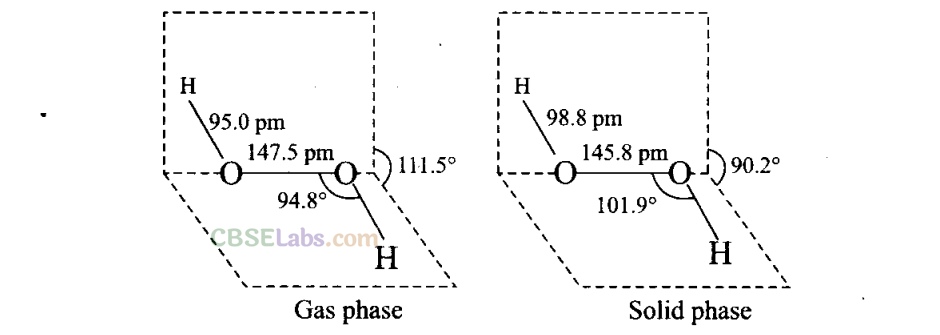
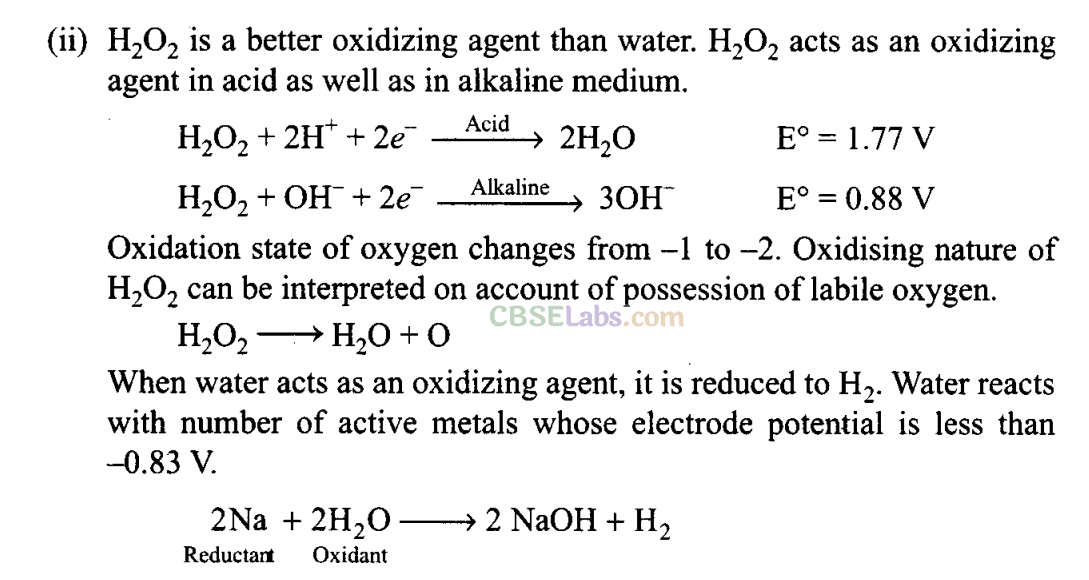
Q41. Melting point, enthalpy of vapourisation and viscosity data of H20 and D20 are given below:
| H2 o | D2 o | |
| Boiling point / K | 373.0 | 374.4 |
| Enthalpy of vapourisation at (373 K)/ kJ mol -1 | 40.66 | 41.61 |
| Viscosity/centipoise | 0.8903 | 1.107 |
On the basis of this data, explain in which of these liquids intermolecular forces are stronger?
Sol: The melting point, enthalpy of vapourisation and viscosity values of all these items depend upon the intermolecular forces
of attraction. Since their values are higher for D 2 0 as compared to those of H 2 0, therefore, intermolecular forces of attraction
are stronger in D 2 0 than in H 2 0.
Q42. Dihydrogen reacts with dioxygen (0
2
) to form water. Write the name and formula of the product when the isotope of hydrogen which has one proton and one neutron in its nucleus is treated with oxygen. Will the reactivity of both the isotopes be the same towards oxygen? Justify your answer.
Sol:
The isotope of hydrogen which contains one proton and one neutron is deuterium (D). Thus, when dideuterium reacts with dioxygen, deuterium oxide, i.e., heavy water is produced.

The reactivity of H
2
and D
2
towards oxygen will be different. Since the D – D bond is stronger than H – H bond, therefore, H
2
is more reactive than D
2
towards reaction with oxygen.
Q43. Explain why HC1 is a gas and HF is a liquid.
Sol:
Due to greater electronegativity of F over Cl, F forms stronger H-bonds as compared to Cl. As a result, more energy is needed to break the H-bonds in HF than in HC1 and hence the b.p. of HF is higher than that of HCl. Consequently, H-F is liquid while HC1 is a gas at room temperature.
Q44. When the first element of the periodic table is treated with dioxygen, it gives a compound whose solid state floats on its liquid state. This compound has an ability to act as an acid as well as a base. What products will be formed when this compound undergoes autoionisation?
Sol:
The first element is hydrogen and its molecular form is dihydrogen (H2). It reacts with oxygen to form water whose solid state is ice which is lighter than water and floats over water.
Water is amphoteric in nature, i.e., it acts as an acid in the presence of strong bases and acts as a base in the presence of strong acids.


Q45. Rohan heard that instructions were given to the laboratory attendant to store a particular chemical, i.e., keep it in the dark room, add some urea in it, and keep it away from dust. This chemical acts as an oxidizing as well as a reducing agent in both acidic and alkaline media. This chemical is important for use in the pollution control treatment of domestic and industrial effluents.
(i) Write the name of this compound.
(ii) Explain why such precautions are taken for storing this chemical.
Sol:
(i) The name of the compound is H
2
0
2
. It acts as an oxidizing as well as reducing agent in both acidic and basic media.
(ii) H
2
0
2
is decomposed by light and dust particles. Urea is added as a negative catalyst, i.e., to check its decomposition.
2H 2 0 2 (1)→2H 2 0(1) + 0 2 (g)
Because of the oxidizing properties, H 2 0 2 is widely used to control pollution by oxidation of harmful cyanides and obnoxious smelling sulphides present in domestic and industrial effluents. It also helps in sewage disposal by supplying 0 2 for oxidation of organic matter present – in sewage waters.
NCERT Exemplar Class 11 Chemistry Solutions
- Chapter 1 Some Basic Concepts of Chemistry
- Chapter 2 Structure of Atom
- Chapter 3 Classification of Elements and Periodicity in Properties
- Chapter 4 Chemical Bonding and Molecular Structure
- Chapter 5 States of Matter
- Chapter 6 Thermodynamics
- Chapter 7 Equilibrium
- Chapter 8 Redox Reactions
- Chapter 9 Hydrogen
- Chapter 10 The s-Block Elements
- Chapter 11 The p-Block Elements
- Chapter 12 Organic Chemistry: Some Basic Principles and Techniques
- Chapter 13 Hydrocarbons
- Chapter 14 Environmental Chemistry